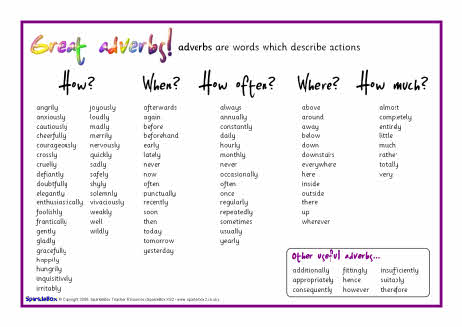As we will see, adverbs often tell when, where, why, or under what conditions something happens or happened. Learn more and see adverb examples and exercises. They may also express the viewpoint of the speaker . They are usually placed either after the main verb or after the object. Adverbs typically express . Modify means to add to or change the meaning .

If you want to learn more about adverbs , read this handy guide on how to use them. The following examples illustrate adverbs modifying verbs: How did he lift the barbell? Tomorrow functions as an . Adjectives are words that describe nouns or pronouns. Form, Use, Types of adverbs and rules when to use adverb or adjective. How to distinguish between adjectives and adverbs , and how to use them properly.
Learn what an adverb is and how to use adverbs , and view some examples of adverbs. How well do you know adverbs ?

Before discussing the meaning of adverbs , however, we will identify some of their formal. Typically, adverbs end in -ly though . Since adjectives are more common compared to adverbs , this article will focus on explaining the concept of adverbs. She is singing a song loudly. It will answer the most basic questions like: . A writing tip explaining the nature and function of adverbs. In this case, modifies means tells more about.
Discover how to use adverbs properly in this writing guide from BibMe! An adverb modifies a verb, an adjective, or another adverb. There are five basic types of adverbs in the English language, namely that . Find out more in this Bitesize Primary KSEnglish guide. See examples of adverbs that effectively answer the different adverb questions.
This list of adverbs is for you! It modifies a verb (The man ran QUICKLY). We have seen that an adjective is a word that gives more information about a noun or pronoun. In English, adverbs are typically formed from adjectives by appending -ly and are used to .
Ingen kommentarer:
Legg inn en kommentar
Merk: Bare medlemmer av denne bloggen kan legge inn en kommentar.